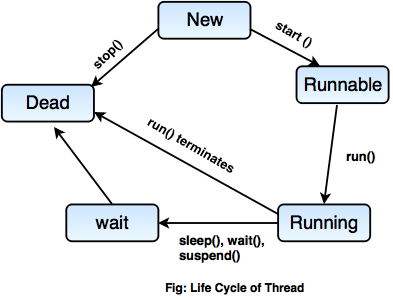
In the realm of Java programming, multithreading plays a pivotal role in enabling concurrent execution and improving the efficiency of applications. Multithreading allows multiple threads to run concurrently within a single program, opening up opportunities for parallel processing, enhanced responsiveness, and efficient resource utilization. Understanding the concept of multithreading in Java is crucial for developers seeking to build robust and high-performing applications. In this blog post, we will explore the essence of multithreading in Java and how Java courses can help you master this fundamental aspect of concurrent programming.
Understanding Multithreading:
In simple terms, multithreading involves the execution of multiple threads concurrently within a single program. A thread represents an independent unit of execution, capable of executing tasks concurrently with other threads. Multithreading empowers developers to perform multiple operations simultaneously, thereby improving the efficiency and responsiveness of Java applications. By learning about multithreading, you can harness its power to build responsive user interfaces, perform parallel computations, and handle complex tasks more efficiently.
Benefits of Multithreading:
Multithreading offers several benefits that make it a crucial concept for Java developers to master. These include:
- Improved Responsiveness: Multithreading allows applications to remain responsive even when executing time-consuming tasks. By executing tasks concurrently, a responsive user interface can be maintained while background processes continue their execution.
- Enhanced Performance: Multithreading enables parallel processing, allowing tasks to be executed simultaneously on multiple CPU cores. This leads to improved performance and faster execution times for computationally intensive operations.
- Efficient Resource Utilization: Multithreading helps maximize the utilization of system resources. By dividing tasks into multiple threads, applications can efficiently utilize CPU cycles and avoid idle time, thereby optimizing resource allocation.
- Asynchronous Operations: Multithreading enables the execution of tasks asynchronously, allowing the application to perform non-blocking operations. Asynchronous programming is vital for handling events, managing I/O operations, and integrating with external services without blocking the main program flow.
Java’s Multithreading Capabilities:
Java provides robust support for multithreading, making it a popular choice for concurrent programming. The Java platform offers several key features and constructs to facilitate the development of multithreaded applications, including:
- Thread Class: Java’s Thread class is at the core of multithreading. It provides the necessary methods and functionality to create, control, and manage threads within a Java program. By extending the Thread class or implementing the Runnable interface, developers can define the behavior of individual threads.
- Synchronization: Java offers synchronization mechanisms, such as the synchronized keyword and locks, to ensure thread safety and prevent race conditions. Synchronization allows threads to coordinate their access to shared resources, enabling safe and consistent data manipulation.
- Thread Pools: Java’s Executor framework simplifies the management of thread execution by providing thread pool implementations. Thread pools offer a pool of reusable threads, reducing the overhead of thread creation and allowing efficient management of concurrent tasks.
- Concurrent Collections: Java’s Concurrent API includes a set of concurrent collections, such as ConcurrentHashMap and ConcurrentLinkedQueue, designed to be thread-safe. These collections enable safe and efficient sharing of data among multiple threads without the need for explicit synchronization.
Java Courses and Multithreading:
To truly grasp the intricacies of multithreading in Java, enrolling in a Java course that specifically covers concurrent programming is highly recommended. A comprehensive Java Course can provide in-depth knowledge and practical experience in implementing multithreaded applications. Here’s how a Java course can help you master multithreading:
- Conceptual Understanding: Java courses offer a structured curriculum that covers the theoretical aspects of multithreading, including thread creation, synchronization, thread communication, and inter-thread coordination. These courses provide a solid foundation in concurrent programming concepts, ensuring you have a clear understanding of how multithreading works in Java.
- Hands-on Practice: Practical exercises and coding assignments offered in Java courses allow you to gain hands-on experience with multithreading. These exercises provide an opportunity to implement multithreaded solutions, solve real-world problems, and understand the nuances of multithreading in Java.
- Best Practices and Patterns: Java courses often emphasize best practices and design patterns specific to multithreading. Learning from experienced instructors or industry professionals helps you understand common pitfalls, techniques for efficient resource sharing, and strategies to avoid race conditions and deadlock situations.
- Performance Optimization: Java courses may cover advanced topics such as thread synchronization, performance tuning, and the Java Memory Model. Understanding these concepts helps you optimize multithreaded applications for better performance, efficient resource utilization, and minimizing contention.
Real-world Applications of Multithreading:
The practical applications of multithreading are vast and diverse. Here are a few examples:
- Web Servers: Web servers utilize multithreading to handle multiple client requests concurrently. Each request is handled by a separate thread, enabling efficient resource utilization and providing a responsive user experience.
- Gaming Applications: Multithreading is crucial in gaming applications to handle rendering, user input, and artificial intelligence concurrently. By utilizing multithreading, gaming applications can provide smooth gameplay and realistic simulations.
- Data Processing: Multithreading is widely used in data processing applications where large datasets need to be processed concurrently. Multithreading allows parallel processing, resulting in faster data analysis and improved application performance.
- Real-time Systems: Multithreading is essential in real-time systems such as financial trading platforms, where timely execution of tasks is critical. By leveraging multithreading, these systems can handle multiple real-time events concurrently.
Conclusion:
Multithreading in Java is a powerful concept that allows developers to unlock the potential of concurrent programming, enabling responsive applications and efficient resource utilization. By understanding the fundamentals of multithreading and enrolling in a Java Course, you can gain the necessary knowledge and skills to implement multithreaded applications effectively. Java courses provide a structured learning path, practical exercises, and insights into best practices, allowing you to master the art of multithreading in Java and build robust, high-performance applications. Embrace the world of multithreading, and harness its capabilities to elevate your Java programming skills to new heights.
